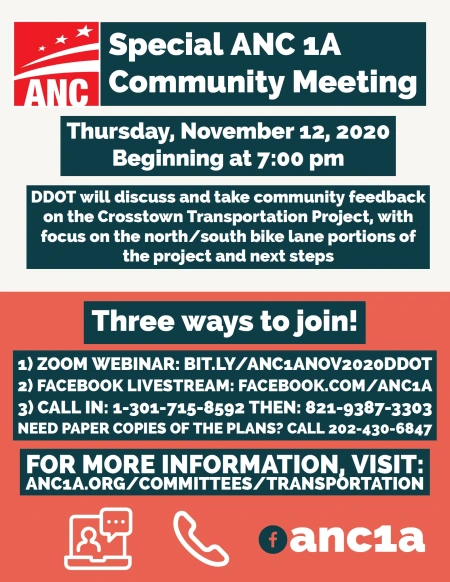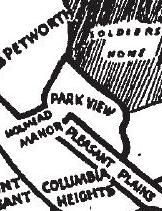While creating a good crosstown transportation connection between Brookland and Adams Morgan is a goal of the recent Crosstown Multimodal Study, this is not a new idea. Creating a good crosstown transportation network has vexed District transportation planners for more than 90 years. DDOT’s Multimodal Study is notable for taking all forms of transportation into consideration. Unfortunately, efforts in the 1920s and 1950s did not do this and prioritized automotive transportation at the expense of walk-ability and the environment. This resulted in blocks without street trees, a four-lane expressway that leads nowhere, and the District’s only transportation cloverleaf at North Capitol and Irving streets.
Both the Irving Street expressway and the cloverleaf intersection at the Washington Hospital Center date to the 1950s and were intended to solve two problems. The first was to establish a better crosstown route. The second was to connect that route to the freeway system in Maryland. Neither of these goals achieve their promise.
One of the earliest efforts to identify Columbia Road as part of an improved crosstown route dates to 1927. It came out of a recommendation to the National Capital Park and Planning Commission by a subcommittee designated to study the traffic plan developed by L.D. Tilton, a St. Louis traffic expert. Tilton’s traffic plan attempted to place all sections of the District of Columbia within a quarter or half mile distance of a selected major thoroughfare. Recommendations to the NCPPC were divided into two divisions – crosstown and radial.
While 18 major traffic thoroughfares were definitely recommended, the proposal to include Columbia Road was tabled to be decided at a later date. This was due to the fact that it was considered unduly narrow between Sixteenth Street and the Soldiers’ Home. While all agreed it was ideally located to serve as a crosstown route, there was doubt that the street could be widened to serve in that capacity.
Never-the-less, two important routes were identified in 1927 that would later play a role in creating the North Capitol and Irving cloverleaf. The relevant radial route consisted of North Capitol Street, Michigan Avenue, Harewood Road, and Blair Road to the District boundary. The relevant crosstown route was Garfield Street, by way of Cleveland Avenue, Calvert Street, and Columbia Road to Sixteenth Street (from Sixteenth Street to the Soldiers’ Home, the matter of widening Columbia Road or combining the route with another street to be decided later). From the Soldiers’ Home the route would continue along Michigan Avenue and Franklin Street to Bladensburg Road.
In 1931, NCPPC used the 1927 thoroughfare plan to prioritize street improvements and paving. While the matter of the crosstown route between Sixteenth Street and the Soldiers’ Home was still undecided, the proposed solution was to develop Colombia Road for westbound traffic and Harvard Street for eastbound traffic – and then to realign the road north of McMillan reservoir to connect this pair with Michigan Avenue to the east.
While the basic corridors were identified in 1927 and expanded in 1931, it wasn’t until the beginning of the 1950s that genuine efforts were made to realize these corridors. The plan consisted of constructing two new highways through the Soldiers’ Home.
The north-south freeway was proposed as a six-lane highway that would end the detour around the Soldiers’ Home and connect North Capitol Street directly with Maryland.
Rather than construct a full-fledged east-west freeway, planners proposed a cheaper alternative. Instead of a freeway, planners proposed a new one-way network – Irving street one-way west and Columbia Road one-way east. Irving would be cut through the Soldiers’ Home to connect with Michigan Avenue at Harwood Road. Other suggestions from this plan included:
- Making Park Place one-way northbound;
- making Warder Street one-way southbound; and,
- realigning Irving Street at 14th Street and Georgia Avenue.
 (Map from the Washington Post, February 20, 1952.)
(Map from the Washington Post, February 20, 1952.)
After two-years of negotiations, the southern 42-acres of the Soldiers’ Home was transferred to the District in late 1954 paving the way for the highway project to move forward. As construction was geared to begin in late 1956, the original plan to use Irving and Columbia Road was altered to include Lamont and Kenyon streets as well. Each street would parallel each other as far as Klingle Road, NW. Harvard Street would later be identified to replace Lamont.
 (Overview of configuration in 1954 from the Evening Star, September 26, 1954.)
(Overview of configuration in 1954 from the Evening Star, September 26, 1954.)

From the Evening Star, 1958.
The narrowness of the streets between the Soldiers’ Home and Sixteenth street was identified in the 1927 plan and not entirely solved with the one-way street scheme. To receive Federal aid for the crosstown street project, the streets included in the network had to be a least 30 feet wide. This meant that several of the streets had to be widened, some as little as 6 inches on each side. This requirement doomed more than 100 street trees which were cut down to make way for the widened streets and new curbs.
For example, Harvard Street between Georgia Avenue and 14th Street was 29 feet wide. To gain the needed extra foot the curbs were moved six inches on either side. To make way for the new curbs on Harvard, 27 trees – 18 pin oaks and nine ginkos – were cut down. To widen Irving Street west of Georgia Avenue by two feet, 40 street trees were cut down. While some of these streets have wonderful tree-line blocks today, other blocks on these routes are still tree-less with no room for street trees.
The one-way street network east of 14th Street and the Irving Street expressway across the former Soldiers’ Home grounds was completed and opened to motorists on October 20th 1958 as work continued on the North Capitol cloverleaf and connecting Kenyon Street to Park Road west of 14th Street. The final stage of the crosstown route project was completed on August 19, 1959, when the final one-way streets were implemented. These were Irving Street between Adams Mill Road and 11th Street (eastbound), Kenyon Street between 11th Street and 14th Street (westbound), and Park Road between 14th Street and 17th Street (westbound).
In a twist of irony, while the effort to complete the crosstown network and cloverleaf intersection were being completed the District Commissioners put a halt to the north-south freeway effort. Even with construction of the North Capitol street extension underway across the Soldiers’ Home grounds, in 1960 the Commissioners followed the recommendation of city highway officials to cancel the contract. While the goal was to tie the North Capitol highway into a major Maryland highway, Maryland officials were uncommitted to the goal.
 (Map of street network configuration in 1958, from the Evening Star, Oct. 19, 1958.)
(Map of street network configuration in 1958, from the Evening Star, Oct. 19, 1958.)
References
“3 Streets Turn One-Way Today.” The Washington Post, Aug. 19, 1959, p. B1.
“18 Thoroughfares Proposed to Serve for Major Traffic.” The Washington Post, Oct. 23, 1927, p. M2.
“Committee Draws Radial Street Plan, Enlarging System.” The Washington Post, Nov. 4, 1927, p. 22.
Deane, James G. “One-Way Crosstown Network Cuts Cost of Freeway Solution.” The Evening Star, Feb. 20, 1952, p. A-14.
Deane, James G. “Two Fast Arteries Would End Roadblock at Soldiers’ Home.” The Evening Star, Feb. 19, 1952, p. A-7.
Gwertzman, Bernard. “Street Widening Dooms More Than 100 Trees Along New Crosstown Route in Northwest.” The Evening Star, Apr. 10, 1958, p. A-21.
“N. Capitol Corridor Plans Job Canceled.” The Evening Star, Feb. 19, 1960, p. B-3.
“Park Road Partly Open For Traffic.” The Washington Post, Dec. 25, 1958, p. B1.
“Priority Paving of Main Streets Urged by Group.” The Evening Star, Dec. 26, 1931, p. A-12.
“Soldiers Home Crossing to Open.” The Washington Post, Oct. 19, 1958, p. B6.
“Soldiers’ Home Crossing To Speed D.C. Traffic.” The Evening Star, Oct. 19, 1958, p. A-23.
“Soldiers’ Home Expressway Will Ease Crosstown Traffic.” The Washington Post, Aug. 20, 1956, p. 34.
Stepp, John W. “42-Acre Soldiers Home Tract Given D.C. for Street Project.” The Evening Star, Sept. 26, 1954, p. 1.
















 "The territory comprising Park View extends from Gresham Street north to Rock Creek Church Road, and from Georgia Avenue to the Soldiers' Home grounds, including the triangle bounded by Park Road, Georgia Avenue, and New Hampshire Avenue" (from Directory and History of Park View, 1921.)
"The territory comprising Park View extends from Gresham Street north to Rock Creek Church Road, and from Georgia Avenue to the Soldiers' Home grounds, including the triangle bounded by Park Road, Georgia Avenue, and New Hampshire Avenue" (from Directory and History of Park View, 1921.)
